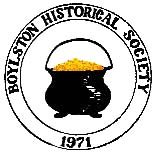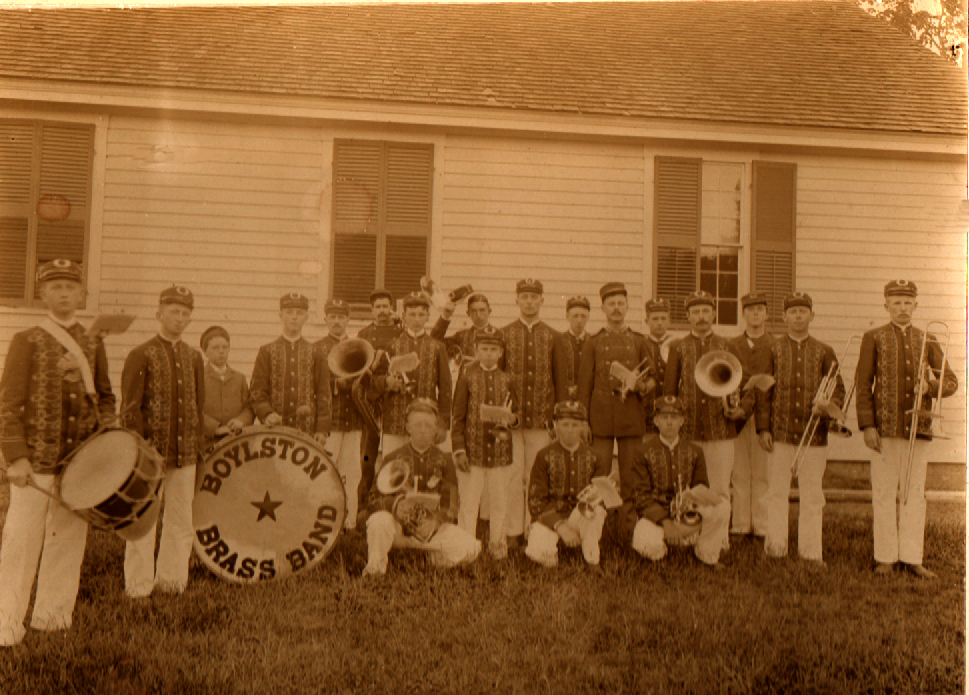Boylston Brass Band
And the Band Played On
On November 15th in 1875, a group of young men from Boylston decided to establish a town brass band, to be known as the Boylston Brass Band. Towns across the country had been doing the same for decades. The Brass Band movement dates back to the early 19th century in England and Europe. As urbanization increased during the industrial revolution, employers supported the growth of these bands as a way to keep people busy during their idle time and discourage political activity that might work against them. At the same time improved manufacturing raised the quality, consistency and availability of brass instruments, this in turn expanded musical education and composition. [1] People were learning to play a musical instrument more often and new music, both popular and classical, was being written all the time.
The bass drum of the Boylston Brass Band: 36” x 36” x 15”. Wood shell and rim with metal hardware for tuning ropes. There are skins on two sides, one side is painted on the non-played side with Boylston Brass Band. There is one drum stick, the head is stitched and filled swede leather with an 18” wooden shaft. There is a hole at the end of the shaft that would accommodate a rope to be placed around the wrist.
The Boylston Brass Band started with little, each member was asked to pay a fee of $5 per annum (about $120 in current value). It is unclear where most of the instruments came from, perhaps each member brought their own, but it was well into their first year that the Band raised the money to buy their own bass drum. Until that time they had hired a drum. They also hired a teacher, Mr Staples from Oakdale, with whom they rehearsed twice weekly and paid $2.50 per session. With his help and their own enthusiasm, they built up their repertoire of songs.
Gradually they were asked to play at more and more events; weddings, anniversaries, birthdays and town gatherings. From time to time, they would hold free concerts at the Town Hall, or host a Fair and Festival, often followed by an Oyster Supper with pies and cakes donated by friends of the Band, those friends being wives, girlfriends and fans. They would often do well by these events netting as much as $95 at a time. Eventually they were able to afford to build a band stand on the common (not the one we see there today) and later to purchase uniforms for the18 members (as seen in the image below).
|
|
The Band would often join other town bands from Shrewsbury, Northborough, and West Boylston to play for important events and new band stand dedications. One particularly exciting out-of-town event for the Band happened January 11, 1877. It was recorded as follows in the Band’s business journal:
“Jan 11th BBB went with a party from Boylston to Southboro. The Band were drawn by a six-horse team. Played going through Northboro, Marlboro, arrived at Dr. Bigelow’s in Southboro at half past one PM. Had a good turkey dinner. Played while there, started home about five PM. Had a good time everything passed off very well. Jennie Cuddy went with the Band as small drummer. About 70 persons went in 7 teams with 22 horses.” [1]
Eventually, after the loss of two consecutive Band Leaders, John T Flagg who died, November 16, 1878 after an illness at the age of 19, and then only a year later Walter Hastings. W. Hastings was suffering bad health and chose to move west to Colorado and then Nevada. The band donated all remaining funds to support W. Hasting with his move and then, according to the records, the Band never met again. In a final journal entry, it tells that W. Hastings recovered and was able to play the coronet again in an orchestra that he had started. Over the course of its five-year life span, the BBB counted the following as members. Perhaps you are a descendent of one and maybe have their instrument in a closet somewhere. If so, we would love to know about it. P. M. Brigham
[1] A Brief History of Brass Bands, http://www.uky.edu/~nabba98/nabba/history.html
Acknowledgments A Brief History of Brass Bands, http://www.uky.edu/~nabba98/nabba/history.html |

